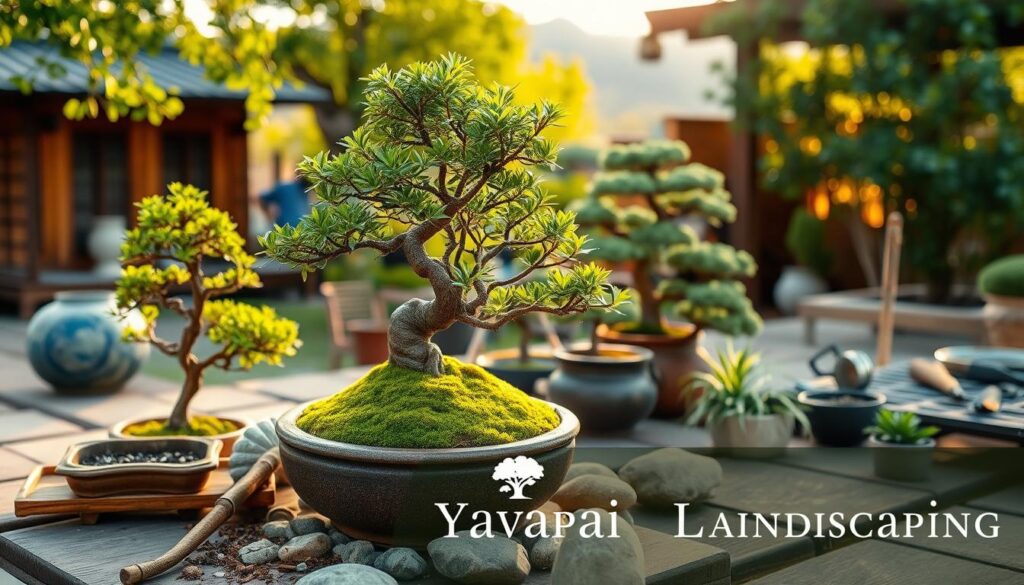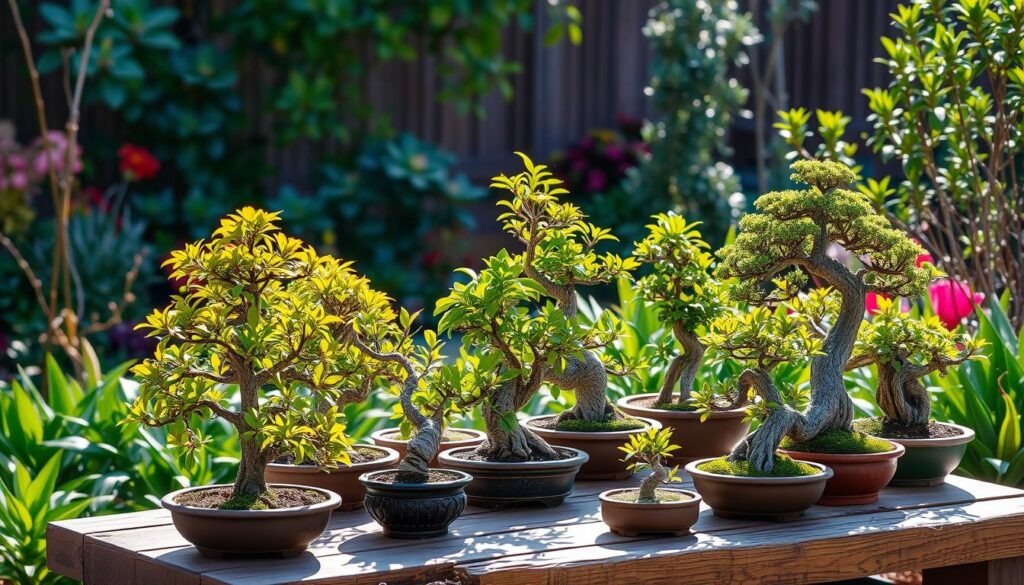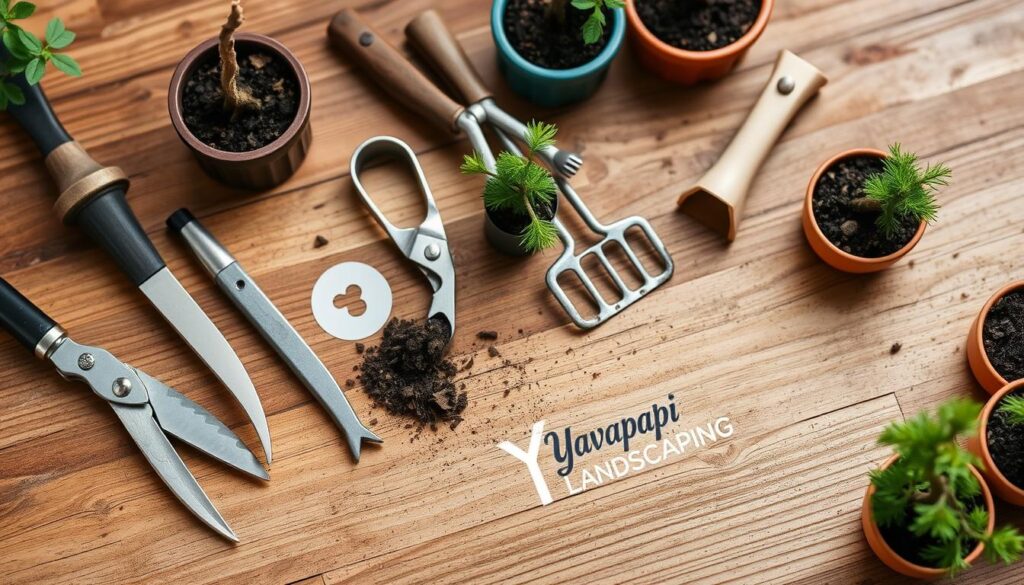
Prescott gardening fans are diving into a new challenge: bonsai. This ancient art of growing small trees is becoming popular here. It combines nature and art, perfect for our local climate.
Bonsai lets gardeners create tiny sculptures. It’s a great way for Prescott gardeners to explore new skills. Caring for these small trees is rewarding and pushes gardening to new heights.
More people are interested in bonsai, and local nurseries are responding. Workshops and classes teach the skills needed to care for these tiny trees. Bonsai is leading a green revolution in Prescott’s gardening scene.
Key Takeaways
- Bonsai is gaining popularity among Prescott gardeners
- Miniature trees offer a unique horticultural challenge
- Bonsai techniques blend art and nature
- Local resources for bonsai cultivation are increasing
- Bonsai adapts well to Prescott’s climate
Introduction to Bonsai: Ancient Art Meets Prescott’s Gardening Scene
Bonsai, the art of growing miniature trees, has captured the hearts of gardeners everywhere. It has found a new home in Prescott, Arizona. Here, local fans appreciate its beauty and the challenge it brings.
Origins of Bonsai in Japanese Culture
Japanese bonsai has a history of over a thousand years. It started as a way to bring nature indoors. Early artists pruned and shaped trees to create living sculptures that showed harmony and balance.
The Rising Popularity of Bonsai in Prescott
In recent years, bonsai has become more popular in Prescott. Local nurseries see more sales of bonsai tools and starter trees. Bonsai clubs have also popped up, offering workshops and exhibitions for all.
Benefits of Bonsai for Local Gardeners
Bonsai offers more than just beauty. It brings benefits to Prescott gardeners:
- Stress relief through mindful pruning and care
- A creative outlet that combines art and nature
- Year-round gardening enjoyment, regardless of outdoor conditions
- Space-efficient gardening for those with limited outdoor areas
As bonsai is popular in Prescott, it connects ancient traditions with modern gardening. This unique art form offers a fresh view of plant cultivation. It inspires gardeners to think small and dream big. This article is a gem – take the time to read it
Selecting the Right Trees for Bonsai Cultivation
Choosing the perfect bonsai tree species for Prescott Gardens is key. The unique climate and environment of this Arizona city are important. Look for drought-tolerant, cold-hardy trees, and the right growth habits.

Native junipers are great for bonsai in Prescott. They thrive in the local climate and have attractive foliage. Pines, like Ponderosa and Pinyon, also work well. Their natural look fits the bonsai style.
For deciduous trees, consider mini oaks or maples. They offer beautiful seasonal changes and fit well in Prescott. Though less common, cottonwoods can make stunning bonsai with their unique bark and leaves.
- Junipers: Drought-tolerant and hardy
- Pines: Rugged appearance, well-suited to local climate
- Oaks and Maples: Offer seasonal color changes
- Cottonwoods: Unique bark and leaf shapes
Remember, smaller leaf varieties are best for a full-sized look in miniature. Visit local nurseries to find Prescott-suitable trees. Also, get advice from experienced bonsai practitioners. You’ll have a beautiful bonsai that thrives in Prescott’s unique environment with the right choice.
Essential Tools and Techniques for Bonsai Cultivation
Starting your bonsai journey in Prescott needs the right tools and techniques. Let’s look at the essentials you’ll need.
Must-Have Bonsai Tools for Beginners
Every bonsai lover needs a basic tool set. These include:
- Pruning shears for trimming branches
- Concave cutters for creating clean cuts
- Wire cutters for removing training wires
- Root hooks for untangling roots during repotting

Pruning and Shaping Techniques
Pruning is key for your bonsai’s shape. Regular pruning helps it grow compact and defines its structure. For Prescott’s climate, prune deciduous trees in late winter and evergreens in early spring.
Use clean, sharp cuts to help it heal and prevent disease.
Wiring Methods for Bonsai Trees
Wiring shapes your bonsai tree. It helps guide branches into the right spots, creating the classic bonsai look. Start with thicker branches and move to smaller ones. Be gentle to avoid damaging the bark.
Remove wires after a few months to prevent scarring.
Mastering these tools and techniques will help you create beautiful miniature trees in Prescott’s unique environment.
Maintaining Your Bonsai: Care and Nurturing Tips
Proper bonsai care is key for your miniature tree’s health and life span. In Prescott, bonsai growing needs special care because of the unique climate. Watering is a big part of bonsai care.
In hot summers, your bonsai might need water every day. But in cooler months, you can water less often. Always check the soil moisture before watering to avoid too much water.
Fertilization is also crucial for your bonsai’s health. Use a balanced, water-soluble fertilizer during the growing season. In Prescott’s climate, adjust your fertilization based on your tree’s growth and the season.
Regular pruning is vital for keeping your bonsai’s shape and size right. It helps your bonsai look its best.
Pest control is another important part of bonsai care. Check your trees often for signs of insects or diseases. If you find any, treat them quickly with organic or chemical solutions.
Seasonal care changes are needed for bonsai care in Prescott. In winter, protect your bonsai from frost by moving it to a sheltered spot or using frost cloths. Give your bonsai shade during the hottest times to prevent leaf burn in summer.
By following these care tips and adjusting them for Prescott’s climate, your bonsai will thrive all year.
Yavapai Landscaping Prescott offers free estimates for Prescott and nearby locations for landscaping & tree services, which include tree elimination, tree pruning, stump grinding, land clearing, storm clean-up, and emergency tree care.
